It’s certain that faceted navigations are an area of SEO which sends shivers down the spines of search professionals.
Why?
Because they can be difficult to manage and, if you get them wrong, can result in a host of issues which would rather be avoided.
It’s due to this apprehension that a lot of faceted navigations are just ‘fit for purpose’; rather than being used as an opportunity to enhance the user experience through guided selling.
Before we get creative, let’s highlight the current best practices and how they’re being used.
Difficulties of using a faceted navigation
There are a number of common issues caused by a poorly implemented faceted navigation structure.
Because each facet has its own set of URL parameters, the more narrowed the search, the higher chance of duplicate content, link equity dilution, index bloat and crawler inefficiency.
The fear being that the page’s content doesn’t change, but each facet has its own unique URL. This limits the opportunity for organic terms to rank because an indefinite amount of pages will essentially compete for the same keyword.
And Google will then waste time (and budget) crawling the same page potentially hundreds of times.
As an example of how quickly this can get out of hand, if you visit the B&Q website and view the mirror section, here’s what you’ll get:
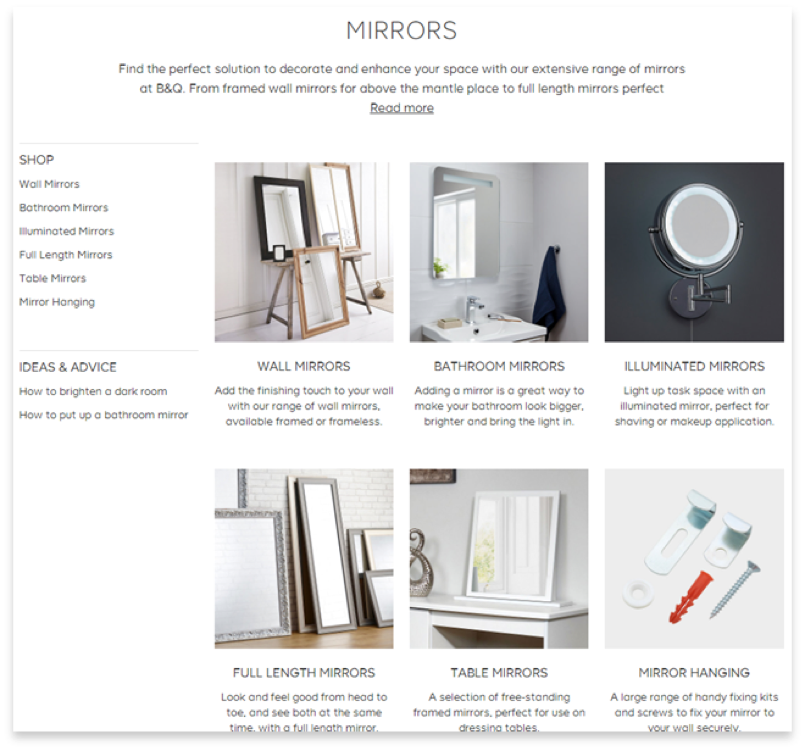
And now, prepare yourselves, here’s what happens when we run a quick site: search with the B&Q’s URL + “mirrors”.
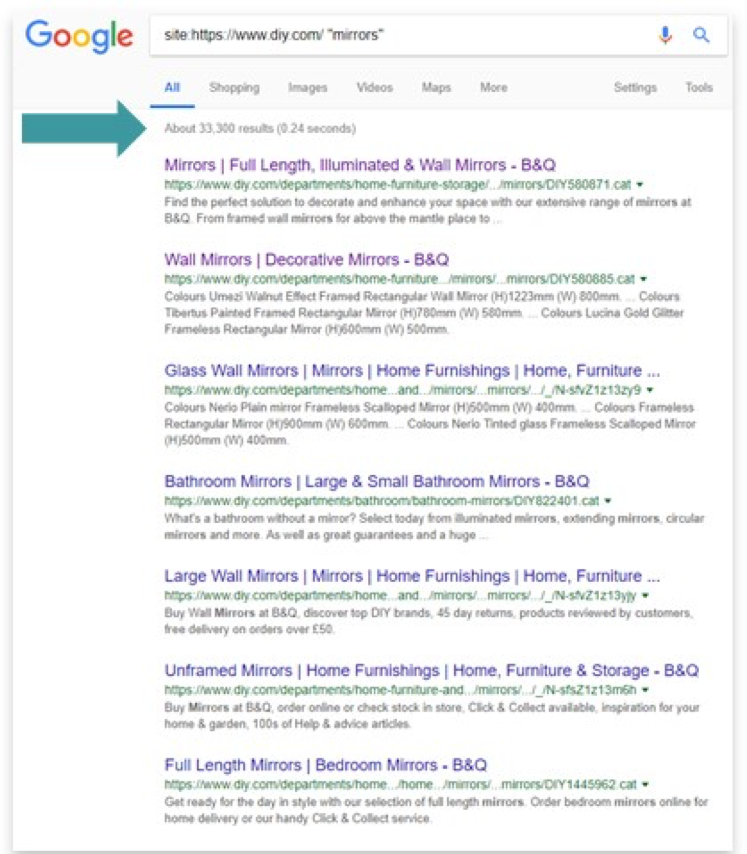
What’s happening here is an overlap in categorisation. Multiple products, appearing in multiple categories, which can be navigated to from within multiple facets.
This is exactly what SEOs don’t want to happen.
Faceted navigation handled correctly
A good example of what you’d expect to see from a large retailer is a very similar number of indexed results in comparison to the on-page products.
If we conduct a similar search for Debenhams using the keyword “jeans”:
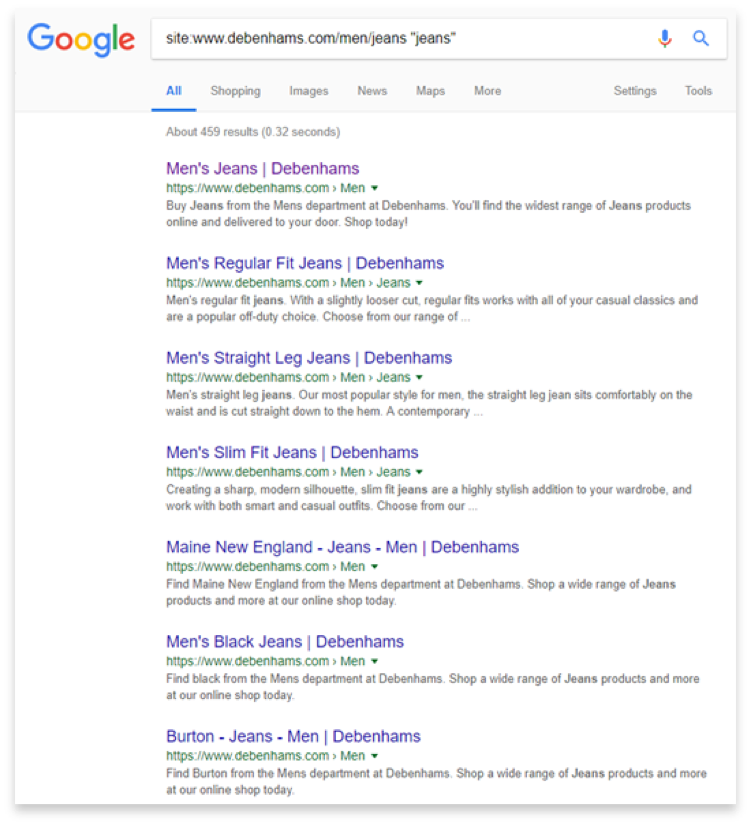
Debenhams has two main categories for jeans: womens and mens. This number of results is likely the same as the listed results on the website. This could be down to a number of reasons:
- Optimised faceted navigation (of course)
- Keyword research to highlight which pages need to be no-indexed and which do not
- A correctly implemented canonical strategy
Well played Debenhams, well played.
Finding opportunity within your facets
There are already a huge variety of articles outlining how to correctly implement and design faceted navigations.
Which is why it’s necessary talk about highlighting real opportunity from within your faceted navigation to drive long-tail traffic.
Keyword research for finding the long-tail
Here’s where the magic happens.
Let’s say a website sells kids beds and it has a number of facets available for users to choose from.
Let’s take the parent category (kids beds) and put it into Ahrefs and work our way through the long-tail phrases to see if we can start creating separate landing pages for search-worthy facet terms.
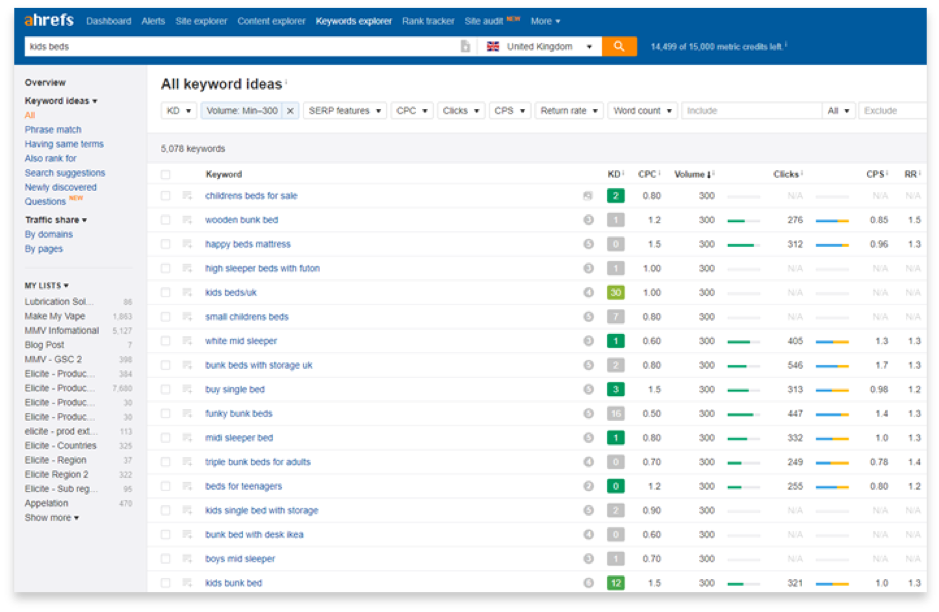
Okay, now you’d want to start picking phrases which directly relate to your products.

Out of the selected keywords, there are already four potential landing pages for:
- Small childrens beds
- White mid sleeper
- Kids single bed with storage
- Kids bunk bed
The theme here is keeping with standard facets so you can apply a similar logic with all of the products across a site.
Using noindex for crawler efficiency
This step is a biggy.
Rather than creating your facets and then gradually adding no-index tags to pages which have no (or little value) to your site, we suggest letting your keyword research drive this decision.
This eliminates the risk of creating unnecessary landing pages to cater for faceted terms, which will only bloat your index with low-quality and potentially harmful URLs.
The key is to manage crawler activity and limit exposure to landing pages which aren’t search oriented.
This reduces the risk of link dilution and crawler inefficiencies.
If you have an existing faceted navigation that causes index bloat, work your way through Google Analytics (combined with keyword research) and begin to eliminate facets which shouldn’t be in the index.
Base this on:
- Potential traffic opportunity
- Existing traffic
- Business KPIs
- Keyword difficulty
Create functional content and then optimise for search
Now it’s about creating functional content to make sure you’re capturing the phrases on-page and optimising for both UX and crawlers.
Google has said in the past that, for eCommerce sites, functional content isn’t a necessity because the purpose of the page is normally understood.
However, as we pointed out in our ‘How To Break into 1st Page of the SERPs’, you can never treat Google’s guidelines as gospel.
We’ve seen sites add content to their product/category pages and then, all of a sudden, their organic performance skyrockets. Causation does not imply correlation, but the data is pretty substantial.
Here’s an example of how valuable functional content can impact your site’s rankings.
Comparing ASOS in 2017 to ASOS in 2018.
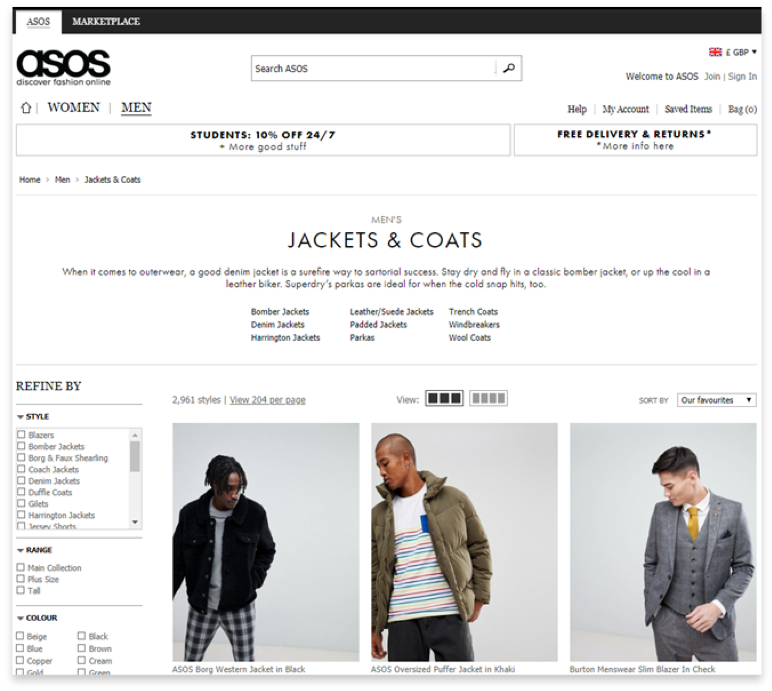
And here’s the same page as of 6th November 2018:

Now, hold onto your seats, here’s a timeline between ASOS having category content, and not.
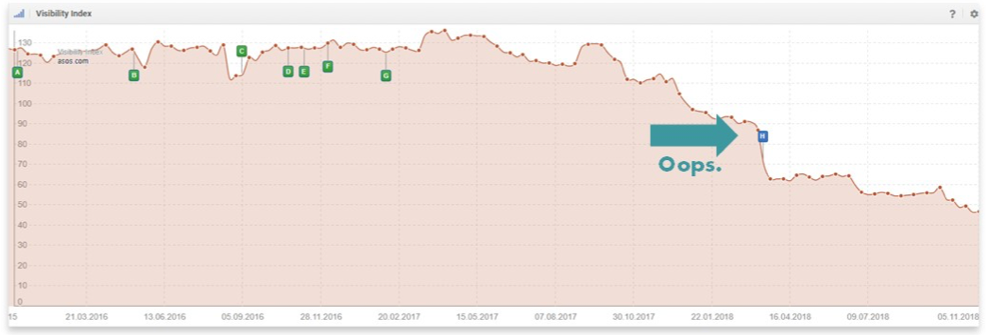
Oops, indeed.
With Google reinforcing the importance of staying away from thin content every year, it pays to be smart about your functional content.
Handle your canonicals
The final step is to then make sure you are now adding a self-referring canonical tag to your new landing pages to make sure Google is indexing your product page; rather than your category.
This is where the niche-opportunity comes from.
Making sure the correct landing page appears for long-tail queries (often product variations) is critical. If you continue to canonical back to the main category page, rather than adding a self-referring canonical, you’re leaving yourself exposed.
The intent is focused, the content is optimised, thus the user experience and crawler signals are better.
If you forget to do this, well, shame on you. We’ve warned you.
Search opportunity and guided journeys for conversions
We’ve covered how we can start targeting long-tail traffic based on faceted product options but, what about top-of-the-funnel users who are going to take a little more persuading to convert?
If you can get the traffic to a site but can’t convert it, you may as well go back to posting flyers through people’s letterboxes.
By improving the first steps of a user’s guided buying journey, you help them find the product they’re looking for faster. Speed is everything for users.
A faceted navigation list is great but a visual helping-hand will go a long way in pushing users into your sales funnel.
You want to guide your users to the product they’re looking for without them having to dig deep into your site’s hierarchy to find it.
AO do it pretty well:

That is AO’s homepage.
From the start, users can filter their options and go directly to a product page. There’s no need for navigating into deeper levels of the site before you find more specific facets. But, when you do, you’re also greeted with an entire range of personalised options:
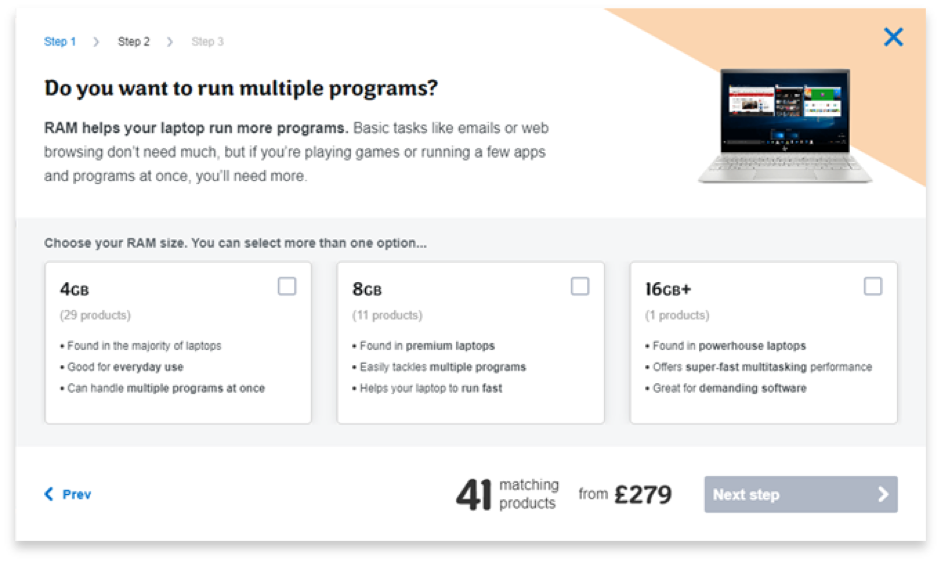
It’s a much more attractive (and effective way) to get users through your facets without relying so heavily on filtering options.
Using a duration-triggered chatbot for the user journey
Intercepting users before they abandon your site is an art.
Seeing this come up on the screen before a user leaves a site, doesn’t entice them - it doesn’t help the user find what they’re looking for and it certainly isn’t going to make them convert.

An exit-intent pop-up could work wonders for sign-ups, but, you’re not actually finding out why the user wants to leave the site and then helping them stay.
The longer it takes a user to find something on your site, the more likely they are to abandon the journey and look elsewhere. Here’s an example of how that user might look when they are looking for laptops, and having to go through the layers of the site.
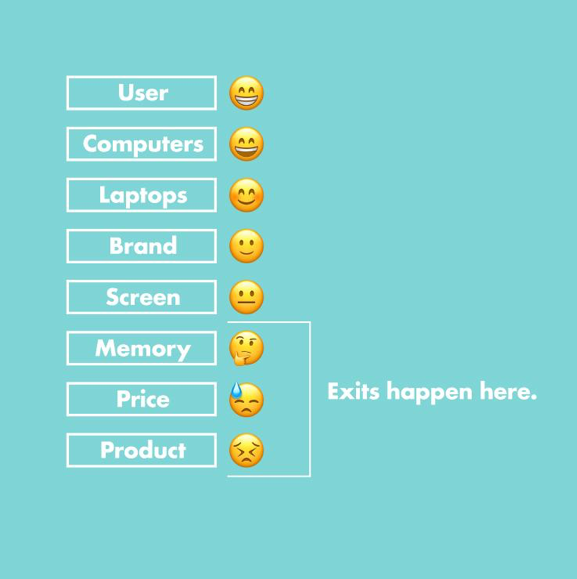
But, with guided selling, we can change the dynamic of how this works for top-of-funnel users.
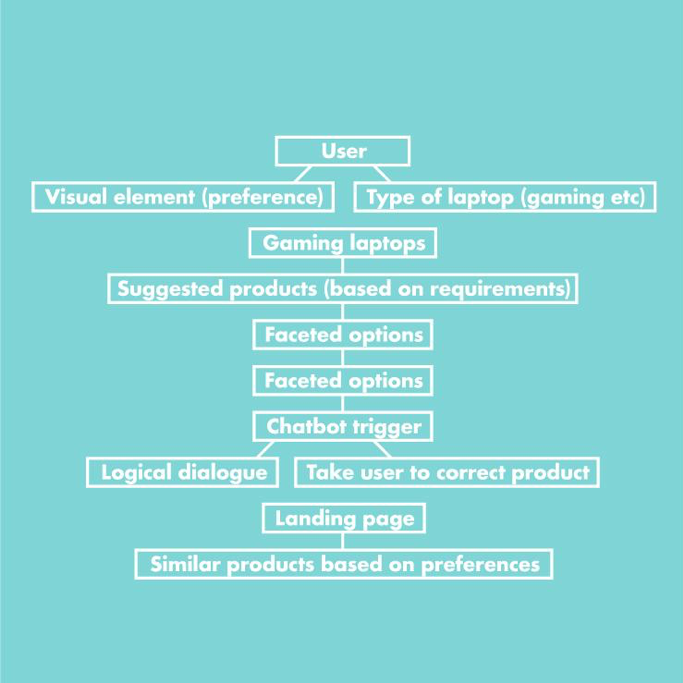
A more personalised experience.
In comparison to a full-screen pop-up, a time-triggered chatbot with recommended products and the ability to guide you, based on your site behaviour, is light years more valuable.
And this is where the coupled dynamic of a faceted navigation and guided selling comes into play.
Your top-of-the-funnel users who aren’t sure what they’re looking for will be guided to a product based on their preference through visual and AI features.
The real gem is that based on your faceted-keyword research, your long-tail phrases will still rank for the run-of-the-mill faceted navigation experience.
It’s no longer about just organic traffic, it should also be about innovating a search strategy to improve the experience for your users.
The conversions and reduced bounce rate will be additional wins.
Combining the two strategies
The ultimate goal here is to capture long-tail traffic and keep users on your site for longer at the same time.
Faceted navigation serves the purpose of capturing specific, bottom-of-the-funnel queries, and guided selling helps users find the right products faster if they find your site during the top-of-the-funnel research stage.
With 28% of all abandonments stemming from a complicated buying process, it’s no wonder why the user journey needs to be aided at every stage.

As with everything SEO, there’s a standard process to follow but not at the cost of innovation and user experience.
We don’t need to reinvent the wheel to see success.
We need to find search opportunity wherever that we can.
If you’re focusing on an efficient buying process from start-to-finish, coupled with visual-aids, your conversions and your organic traffic will positively influence your revenue.
Share your thoughts
We’re all here to learn!
If you have any secret recipes which you are willing to share, then let us know in the comments. Our aim is to move the industry forward as a collective group of search professionals, so, let’s get innovative!
Sign up for our monthly newsletter and follow us on social media for the latest news.





 Proudly part of IPG Mediabrands
Proudly part of IPG Mediabrands